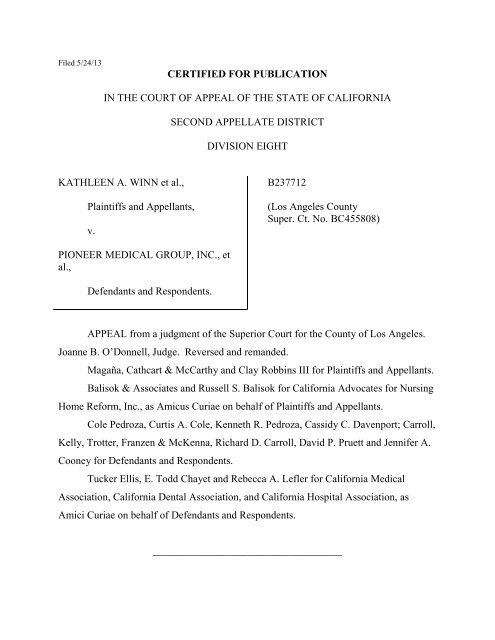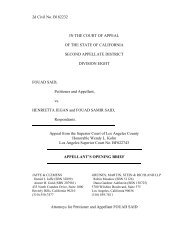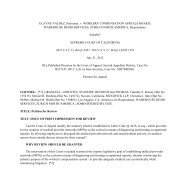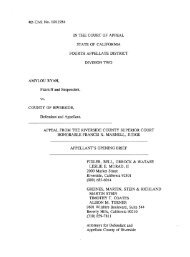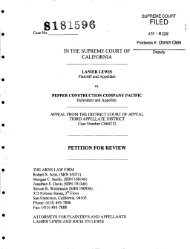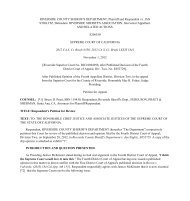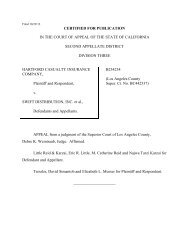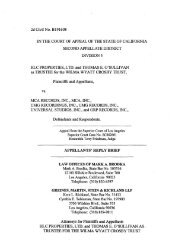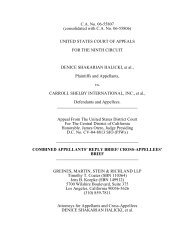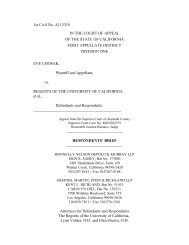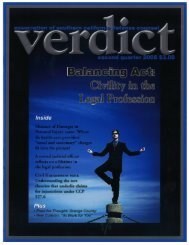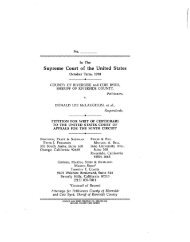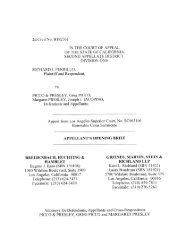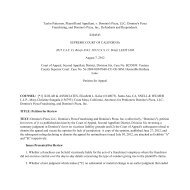Court of Appeal opinion
Court of Appeal opinion
Court of Appeal opinion
Create successful ePaper yourself
Turn your PDF publications into a flip-book with our unique Google optimized e-Paper software.
Filed 5/24/13<br />
CERTIFIED FOR PUBLICATION<br />
IN THE COURT OF APPEAL OF THE STATE OF CALIFORNIA<br />
SECOND APPELLATE DISTRICT<br />
DIVISION EIGHT<br />
KATHLEEN A. WINN et al.,<br />
Plaintiffs and Appellants,<br />
v.<br />
B237712<br />
(Los Angeles County<br />
Super. Ct. No. BC455808)<br />
PIONEER MEDICAL GROUP, INC., et<br />
al.,<br />
Defendants and Respondents.<br />
APPEAL from a judgment <strong>of</strong> the Superior <strong>Court</strong> for the County <strong>of</strong> Los Angeles.<br />
Joanne B. O‟Donnell, Judge. Reversed and remanded.<br />
Magaña, Cathcart & McCarthy and Clay Robbins III for Plaintiffs and Appellants.<br />
Balisok & Associates and Russell S. Balisok for California Advocates for Nursing<br />
Home Reform, Inc., as Amicus Curiae on behalf <strong>of</strong> Plaintiffs and Appellants.<br />
Cole Pedroza, Curtis A. Cole, Kenneth R. Pedroza, Cassidy C. Davenport; Carroll,<br />
Kelly, Trotter, Franzen & McKenna, Richard D. Carroll, David P. Pruett and Jennifer A.<br />
Cooney for Defendants and Respondents.<br />
Tucker Ellis, E. Todd Chayet and Rebecca A. Lefler for California Medical<br />
Association, California Dental Association, and California Hospital Association, as<br />
Amici Curiae on behalf <strong>of</strong> Defendants and Respondents.<br />
____________________________________
SUMMARY<br />
After the death <strong>of</strong> their 83-year-old mother, plaintiffs sued defendant physicians<br />
for elder abuse, based on defendants‟ repeated decisions not to refer their mother to a<br />
vascular specialist over a two-year period during which her diminishing vascular flow<br />
worsened without treatment. Plaintiffs‟ mother began receiving medical care from<br />
defendants in 2000, and by 2004, defendants knew she suffered from impaired lower<br />
vascular flow. In 2007, when she was under the sole medical care <strong>of</strong> the defendants, one<br />
<strong>of</strong> the defendant doctors diagnosed her with peripheral vascular disease. Defendants<br />
failed to refer plaintiffs‟ mother for specialized vascular care despite defendants‟<br />
knowledge <strong>of</strong> her impaired lower vascular flow, their own diagnosis <strong>of</strong> peripheral<br />
vascular disease, the progressive deterioration over the two-year period <strong>of</strong> the vascular<br />
flow in her right leg, and their own notes <strong>of</strong> findings well known to be consistent with<br />
tissue damage due to vascular insufficiency. The day defendants last saw plaintiffs‟<br />
mother, and noted abnormal weight loss, they again made no referral for a vascular<br />
consult. The next day, she was admitted to a hospital with a two-week history <strong>of</strong><br />
gangrene.<br />
Her “right foot was black due to tissue death caused by the long term impaired<br />
vascular flow Defendants had charted, and ignored, for years.” Emergency vascular<br />
surgery was performed, without success, because <strong>of</strong> defendants‟ decisions that withheld<br />
needed medical care. A month later, plaintiffs‟ mother was re-admitted for a below-theknee<br />
amputation <strong>of</strong> her right leg. Two months later, she underwent an above-the-knee<br />
amputation <strong>of</strong> her right leg. Seven months later, she was hospitalized with blood<br />
poisoning, and died.<br />
Defendants contend they cannot be liable for elder abuse because they treated<br />
decedent as an outpatient, and liability for elder abuse “requires assumption <strong>of</strong> custodial<br />
obligations.” They also contend the conduct plaintiffs allege constitutes only<br />
pr<strong>of</strong>essional negligence and, as a matter <strong>of</strong> law, does not amount to the “reckless neglect”<br />
required for a claim <strong>of</strong> elder abuse.<br />
2
Defendants are mistaken on both points. The elder abuse statute does not limit<br />
liability to health care providers with custodial obligations, and the question whether<br />
defendants‟ conduct was reckless rather than merely negligent is for a jury to decide. We<br />
therefore reverse the trial court‟s judgment dismissing plaintiffs‟ complaint.<br />
FACTS<br />
The plaintiffs are Kathleen A. Winn and Karen Bredahl, the daughters and<br />
surviving heirs <strong>of</strong> Elizabeth M. Cox. The defendants are Pioneer Medical Group, Inc.,<br />
Emerico Csepanyi, James Chinuk Lee and Stanley Lowe. Doctors Csepanyi, Lee and<br />
Lowe are licensed physicians or podiatrists, who maintained <strong>of</strong>fices at Pioneer Medical<br />
Group in Cerritos and Long Beach. Plaintiffs‟ first amended complaint alleges the<br />
following facts.<br />
Mrs. Cox began receiving medical care from Dr. Csepanyi at Pioneer‟s facilities as<br />
early as November 2000. In 2004, she was evaluated by Dr. Lowe, a podiatrist, who<br />
treated her for “ „painful onychomycosis,‟ ” a condition “well known to limit mobility<br />
and indirectly impair peripheral circulation.” Dr. Lowe recorded that pulses in the upper<br />
surface <strong>of</strong> Mrs. Cox‟s foot “were not palpable reflecting [Mrs. Cox] had severely<br />
impaired vascular flow in her lower legs.” Dr. Lowe‟s 2004 report showed that a copy <strong>of</strong><br />
the report was sent to Dr. Csepanyi. Thus, both Dr. Lowe and Dr. Csepanyi knew that<br />
Mrs. Cox suffered from impaired lower vascular flow, and “also knew that if prompt<br />
referral to a vascular specialist was not made at that time there was a high degree <strong>of</strong><br />
probability that [Mrs. Cox] would sustain serious injury because <strong>of</strong> her age and medical<br />
history.”<br />
Beginning in February 2007 and until March 2009, while Mrs. Cox was under<br />
their sole medical care, defendants “repeatedly made the conscious decision not to<br />
provide needed medical care to [Mrs. Cox] under circumstances where Defendants . . .<br />
knew that [Mrs. Cox] would be harmed by Defendants‟ failure to provide the medical<br />
care,” and “were therefore reckless in their care <strong>of</strong> [Mrs. Cox].”<br />
In January and February 2007, Mrs. Cox‟s “vascular issues regarding her lower<br />
extremities grew worse.” Defendants‟ records show Mrs. Cox “complained <strong>of</strong> ankle<br />
3
edema, that her feet were discolored and evidenced „decreased circulation.‟ ” Dr.<br />
Csepanyi diagnosed her with peripheral vascular disease on February 13, 2007.<br />
“Although he knew [Mrs. Cox] had suffered from decreased vascular flow since 2004[,]<br />
that said condition was becoming worse without treatment over time, and that [Mrs. Cox]<br />
was at risk <strong>of</strong> severe injury as a result, he did not refer her for a vascular consult.”<br />
From February 2007 until April 2009, “Mrs. Cox‟s right leg vascular condition<br />
progressively deteriorated[,] as repeatedly noted by Defendants in [her] medical chart.”<br />
In December 2007, Dr. Lowe evaluated Mrs. Cox and “noted that the pulses in her<br />
lower legs and feet were further reduced, and recommended a follow-up in two months.<br />
Notwithstanding the deterioration <strong>of</strong> the vascular flow in the legs <strong>of</strong> [Mrs. Cox],<br />
Defendants decided not to make a referral to a vascular specialist.”<br />
In February 2008, Dr. Lowe noted Mrs. Cox‟s “vascular examination was<br />
„unremarkable,‟ while also noting that she „had an abscess <strong>of</strong> the lateral aspect <strong>of</strong> the<br />
right hallux nail plate and cellulitic [acute spreading bacterial infection below the surface<br />
<strong>of</strong> the skin] changes <strong>of</strong> the left hallux nail plate.‟ These findings are well known in the<br />
health care pr<strong>of</strong>ession to be consistent with tissue damage due to vascular insufficiency.<br />
He merely drained the infection, prescribed medication, and suggested another follow-up<br />
in two months. He decided not to refer [Mrs. Cox] to a vascular specialist.”<br />
In July 2008, Dr. Csepanyi examined Mrs. Cox and confirmed she continued to<br />
suffer from peripheral vascular disease. Dr. Csepanyi saw Mrs. Cox again one month<br />
later but did not perform a vascular examination.<br />
In December 2008, Dr. Lee evaluated Mrs. Cox, who had suffered a laceration on<br />
her right foot and right second toe. He cleaned the wound and recommended antibiotics.<br />
Mrs. Cox returned to Dr. Lee for follow-up in January 2009, as Dr. Lee had instructed.<br />
Mrs. Cox was “still complaining <strong>of</strong> pain and that her right big toe was not healing.”<br />
Later in January 2009, Mrs. Cox returned again to see Dr. Csepanyi, complaining the<br />
wound had not healed and was painful. Dr. Csepanyi recommended medication and foot<br />
soaks. On February 9, 2009, he diagnosed cellulitis <strong>of</strong> the toes, cyanosis (skin turning<br />
blue/purple), and a toe abscess. The symptoms defendants noted in January and February<br />
4
2009 “are evidence <strong>of</strong> cellular deterioration and tissue destruction due to peripheral<br />
vascular ischemia and, given the past medical history <strong>of</strong> [Mrs. Cox], the only appropriate<br />
care at that time (after cleaning the wound) would have been a referral to a vascular<br />
specialist, as [Mrs. Cox] was then at clear risk <strong>of</strong> serious injury due to progressive<br />
peripheral vascular insufficiency.”<br />
Mrs. Cox saw Dr. Lowe on February 10, 2009, and three other times in February<br />
and March 2009. On February 10, he “recognized that Ms. Cox suffered from chronic<br />
non decubitus (due to vascular compromise) ulcer <strong>of</strong> the toes, more clearly evidencing<br />
tissue destruction caused by vascular insufficiency.” He recommended topical cream and<br />
a special shoe, but made no referral to a specialist. In the three subsequent visits, Dr.<br />
Lowe “continued to document her active problems <strong>of</strong> pain and non-healing foot wounds.<br />
During two <strong>of</strong> these visits, Dr. Lowe reported that he could not feel a pulse in her feet.<br />
These persistent symptoms are clear evidence <strong>of</strong> tissue deterioration due to peripheral<br />
vascular ischemia.” Given Mrs. Cox‟s medical history, “Defendants‟ decision not to<br />
provide needed medical care clearly exposed [Mrs. Cox] to the immediate risk <strong>of</strong> serious<br />
injury due to her long standing and known condition <strong>of</strong> peripheral vascular<br />
insufficiency,” depriving her <strong>of</strong> needed medical care under circumstances that he knew<br />
would expose [her] to harm.<br />
On March 18, 2009, Mrs. Cox saw Dr. Csepanyi, who again acknowledged Mrs.<br />
Cox suffered from “ „chronic non decubitus ulcer <strong>of</strong> toes,‟ ” a condition “well known in<br />
the medical field to be caused by the „peripheral vascular disease‟ as he had previously<br />
noted (and continued to chart).” Though Dr. Csepanyi also saw Mrs. Cox had suffered<br />
from an abnormal weight loss, no follow-up plan was noted and no referral was made.<br />
“By these decisions Defendants again consciously deprived [Mrs. Cox] <strong>of</strong> needed<br />
medical care under circumstances where they knew [she] was certain to be harmed by the<br />
failure <strong>of</strong> Defendants to provide that care.”<br />
The next day, Mrs. Cox was admitted to a hospital “with symptoms consistent<br />
with a history <strong>of</strong> right lower extremity ischemia (inadequate blood supply to a local area<br />
due to blockage <strong>of</strong> the blood vessels) and a two-week history <strong>of</strong> right first toe gangrene.<br />
5
Her right foot was black due to tissue death caused by the long term impaired vascular<br />
flow Defendants had charted, and ignored, for years. She had lost 30 pounds from<br />
December 2008[.] . . . [Her] foot was black because she had been suffering from sepsis<br />
(blood poisoning) due to the gangrene in her right foot.” A vascular surgery consultation<br />
occurred on an emergency basis; a revascularization procedure “was unsuccessful<br />
because <strong>of</strong> Defendants‟ decisions that withheld needed medical care.” In April, Mrs.<br />
Cox‟s right leg was amputated below the knee, and in June, Mrs. Cox had an above-theknee<br />
amputation. In January 2010 she was hospitalized with blood poisoning and died a<br />
few days later.<br />
Plaintiffs filed a complaint for elder abuse on February 23, 2011. Defendants‟<br />
demurrer was sustained and plaintiffs filed a first amended complaint. Plaintiffs alleged<br />
the conduct related above, and alleged defendants‟ “conscious failure to make . . . a<br />
vascular referral at any time” during the period between December 8, 2008 and March 3,<br />
2009, constituted abuse or neglect as defined by the Elder Abuse and Dependent Adult<br />
Civil Protection Act (hereafter Elder Abuse Act or Act). 1 “Defendants . . . repeatedly, for<br />
at least two years, failed to provide such needed medical care to [Mrs. Cox] under<br />
circumstances where Defendants . . . knew the health and well-being <strong>of</strong> [Mrs. Cox]<br />
depended on such care.” This failure “reflects a deliberate disregard for the high degree<br />
<strong>of</strong> probability that significant injury and certain suffering would befall [Mrs. Cox] as a<br />
result <strong>of</strong> Defendants‟ decisions” and “constitute[s] recklessness within the meaning <strong>of</strong>”<br />
the elder abuse statute. Plaintiffs sought damages, costs, attorney fees, and punitive<br />
damages.<br />
Defendants again demurred, and sought and obtained judicial notice <strong>of</strong> a<br />
complaint plaintiffs had filed for medical malpractice in March 2010.<br />
The trial court sustained defendants‟ demurrer to the first amended complaint<br />
without leave to amend, concluding that plaintiffs “failed to provide facts showing that<br />
the defendants denied the decedent needed care in a reckless sense as is required for a<br />
1 Welfare and Institutions Code section 15600 et seq. All further statutory<br />
references are to the Welfare and Institutions Code unless otherwise identified.<br />
6
violation <strong>of</strong> the Elder Abuse Act[.] . . . Instead, the allegations describe pr<strong>of</strong>essional<br />
negligence and incompetence which, without malice, oppression, or fraud are insufficient<br />
to support a claim for neglect under the Elder Abuse Act.”<br />
The court ordered dismissal <strong>of</strong> the complaint and this appeal followed. We<br />
granted requests to file amicus curiae briefs by the California Medical Association,<br />
California Dental Association and California Hospital Association in support <strong>of</strong><br />
defendants, and by California Advocates for Nursing Home Reform in support <strong>of</strong><br />
plaintiffs.<br />
DISCUSSION<br />
1. The Standard <strong>of</strong> Review<br />
A demurrer tests the legal sufficiency <strong>of</strong> the complaint. We review the complaint<br />
de novo to determine whether it alleges facts sufficient to state a cause <strong>of</strong> action. For<br />
purposes <strong>of</strong> review, we accept as true all material facts alleged in the complaint, but not<br />
contentions, deductions or conclusions <strong>of</strong> fact or law. We also consider matters that may<br />
be judicially noticed. (Blank v. Kirwan (1985) 39 Cal.3d 311, 318.)<br />
2. The Legal Background – The Elder Abuse Act<br />
This case requires us to construe the Elder Abuse Act. Plaintiffs contend they<br />
have stated a claim under the Act, and defendants contend they have not, both because a<br />
defendant must have “custodial obligations” to be liable under the Act and because the<br />
allegations show only pr<strong>of</strong>essional negligence, not neglect within the meaning <strong>of</strong> the Act.<br />
We do not read the Act or the cases construing it the way defendants and their amici<br />
contend it should be limited.<br />
Section 15657 provides in relevant part: “Where it is proven by clear and<br />
convincing evidence that a defendant is liable for physical abuse . . . , or neglect . . . , or<br />
fiduciary abuse . . . [<strong>of</strong> an elderly or dependent adult], and that the defendant has been<br />
guilty <strong>of</strong> recklessness, oppression, fraud, or malice in the commission <strong>of</strong> this abuse, the<br />
following shall apply, in addition to all other remedies otherwise provided by law: []<br />
(a) The court shall award to the plaintiff reasonable attorney‟s fees and costs.” (§ 15657,<br />
subd. (a).) In addition, the limitations <strong>of</strong> section 377.34 <strong>of</strong> the Code <strong>of</strong> Civil Procedure,<br />
7
prohibiting a deceased plaintiff‟s estate from obtaining pain and suffering damages, do<br />
not apply, although the damages may not exceed those permitted under subdivision (b) <strong>of</strong><br />
section 3333.2 <strong>of</strong> the Civil Code (limiting recovery <strong>of</strong> noneconomic losses to $250,000).<br />
(§ 15657, subd. (b).) To recover against an employer, the plaintiff must meet the<br />
standards set in section 3294 <strong>of</strong> the Civil Code for imposition <strong>of</strong> punitive damages on an<br />
employer based upon the acts <strong>of</strong> an employee. (§ 15657, subd. (c).)<br />
Under the Elder Abuse Act, “neglect” is defined to include “[t]he negligent failure<br />
<strong>of</strong> any person having the care or custody <strong>of</strong> an elder or a dependent adult to exercise that<br />
degree <strong>of</strong> care that a reasonable person in a like position would exercise.” (§ 15610.57,<br />
subd. (a)(1).) Neglect “includes, but is not limited to,” a number <strong>of</strong> failures listed in the<br />
statute, including “[f]ailure to provide medical care for physical and mental health needs”<br />
(§ 15610.57, subd. (b)(2)) and “[f]ailure to protect from health and safety hazards.”<br />
(§ 15610.57, subd. (b)(3).)<br />
The Elder Abuse Act excludes liability for acts <strong>of</strong> pr<strong>of</strong>essional negligence.<br />
Section 15657.2 provides: “Notwithstanding this article, a cause <strong>of</strong> action for injury or<br />
damage against a health care provider, . . . based on the health care provider‟s alleged<br />
pr<strong>of</strong>essional negligence, shall be governed by those laws which specifically apply to<br />
those pr<strong>of</strong>essional negligence causes <strong>of</strong> action.” (§ 15657.2.) “Those laws” include<br />
several statutes referred to as MICRA (Medical Injury Compensation Reform Act <strong>of</strong><br />
1975) that restrict causes <strong>of</strong> action and remedies for the pr<strong>of</strong>essional negligence <strong>of</strong> health<br />
care providers, including notice provisions, caps on attorney contingency fees, and a<br />
$250,000 cap on noneconomic damages. (See Delaney v. Baker (1999) 20 Cal.4th 23,<br />
28, fn. 2 (Delaney).) The Elder Abuse Act does not apply to simple or gross negligence<br />
by health care providers. (Covenant Care, Inc. v. Superior <strong>Court</strong> (2004) 32 Cal.4th 771,<br />
785 (Covenant Care).)<br />
To obtain the enhanced remedies <strong>of</strong> section 15657, “a plaintiff must demonstrate<br />
by clear and convincing evidence that defendant is guilty <strong>of</strong> something more than<br />
negligence; he or she must show reckless, oppressive, fraudulent, or malicious conduct.”<br />
(Delaney, supra, 20 Cal.4th at p. 31.) “ „Recklessness‟ refers to a subjective state <strong>of</strong><br />
8
culpability greater than simple negligence, which has been described as a „deliberate<br />
disregard‟ <strong>of</strong> the „high degree <strong>of</strong> probability‟ that an injury will occur [citations].<br />
Recklessness, unlike negligence, involves more than „inadvertence, incompetence,<br />
unskillfulness, or a failure to take precautions‟ but rather rises to the level <strong>of</strong> a „conscious<br />
choice <strong>of</strong> a course <strong>of</strong> action . . . with knowledge <strong>of</strong> the serious danger to others involved<br />
in it.‟ [Citation.]” (Id. at pp. 31-32.)<br />
Delaney, construing the Act‟s provisions on reckless conduct and pr<strong>of</strong>essional<br />
negligence (§§ 15657 and 15657.2), concluded that “ „reckless neglect‟ under section<br />
15657 is distinct from causes <strong>of</strong> action „based on . . . pr<strong>of</strong>essional negligence‟ within the<br />
meaning <strong>of</strong> section 15657.2.” (Delaney, supra, 20 Cal.4th at p. 31.) So, the court held,<br />
“a health care provider which engages in the „reckless neglect‟ <strong>of</strong> an elder adult within<br />
the meaning <strong>of</strong> section 15657 will be subject to section 15657‟s heightened remedies.”<br />
(Id. at p. 27.) “Neglect” under the Act, the Supreme <strong>Court</strong> tells us, “refers not to the<br />
substandard performance <strong>of</strong> medical services but, rather, to the „failure <strong>of</strong> those<br />
responsible for attending to the basic needs and comforts <strong>of</strong> elderly or dependent adults,<br />
regardless <strong>of</strong> their pr<strong>of</strong>essional standing, to carry out their custodial obligations.‟<br />
[Citation.] Thus, the statutory definition <strong>of</strong> „neglect‟ speaks not <strong>of</strong> the undertaking <strong>of</strong><br />
medical services, but <strong>of</strong> the failure to provide medical care. [Citation.]” (Covenant Care,<br />
supra, 32 Cal.4th at p. 783, citing Delaney, supra, 20 Cal.4th at p. 34.)<br />
3. The Contentions in This Case<br />
a. The custodial obligation issue<br />
Defendants assert that, to be liable under the Elder Abuse Act, a defendant “must<br />
have „custodial obligations,‟ not merely provide care.” In other words, they say that<br />
Delaney‟s holding—that health care providers who engage in reckless neglect are subject<br />
to the Elder Abuse Act—applies only to health care providers (such as skilled nursing<br />
facilities) that owe custodial obligations to an elder. But that is contrary to the plain<br />
language <strong>of</strong> the statute, and to the language in Delaney holding that a health care provider<br />
that engages in the “reckless neglect” <strong>of</strong> an elder is subject to the Act‟s heightened<br />
remedies. (Delaney, supra, 20 Cal.4th at p. 27.)<br />
9
This very question was addressed in Mack v. Soung (2000) 80 Cal.App.4th 966<br />
(Mack). In that case, the defendant physician claimed that he could not be liable under<br />
the Elder Abuse Act because he was not the decedent‟s “custodian or caretaker.” (Mack,<br />
at p. 973.) Specifically, he contended the language in section 15610.57, subdivision<br />
(a)(1), referring to “any person having the care or custody <strong>of</strong> an elder” applied “only to<br />
institutional health care facilities and cannot apply to physicians such as himself, who<br />
merely treat elderly patients on an „as needed‟ basis.” (Mack, at p. 974.) Mack rejected<br />
the defendant‟s claim in no uncertain terms.<br />
Mack explained: “The Act was expressly designed to protect elders and other<br />
dependent adults who „may be subjected to abuse, neglect, or abandonment . . . .‟<br />
(§ 15600, subd. (a).) Within the Act, two groups <strong>of</strong> persons who ordinarily assume<br />
responsibility for the „care and custody‟ <strong>of</strong> the elderly are identified and defined: health<br />
practitioners and care custodians. A „health practitioner‟ is defined in section 15610.37<br />
as a „physician and surgeon, psychiatrist, psychologist, dentist, . . .‟ etc., who „treats an<br />
elder . . . for any condition.‟ (Italics added.) „Care custodians,‟ on the other hand, are<br />
administrators and employees <strong>of</strong> public and private institutions that provide „care or<br />
services for elders or dependent adults,‟ including nursing homes, clinics, home health<br />
agencies, and similar facilities which house the elderly. (§ 15610.17.) The Legislature<br />
thus recognized that both classes <strong>of</strong> pr<strong>of</strong>essionals—health practitioners as well as care<br />
custodians—should be charged with responsibility for the health, safety and welfare <strong>of</strong><br />
elderly and dependent adults. This recognition is made explicit in the „reporting‟ section<br />
<strong>of</strong> the Act which states that „[a]ny person who has assumed full or intermittent<br />
responsibility for care or custody <strong>of</strong> an elder or dependent adult, whether or not that<br />
person receives compensation, including . . . any elder or dependent adult care custodian,<br />
health practitioner, . . . is a mandated reporter.‟ (§ 15630, subd. (a), italics added.)”<br />
(Mack, supra, 80 Cal.App.4th at p. 974.)<br />
Mack continued by pointing out that another section <strong>of</strong> the Act defining “abuse”<br />
imposes liability only on “care custodians.” (Mack, supra, 80 Cal.App.4th at p. 974,<br />
citing § 15610.07, subd. (b).) Section 15610.07 defines abuse <strong>of</strong> an elder to include<br />
10
“[t]he deprivation by a care custodian <strong>of</strong> goods or services that are necessary to avoid<br />
physical harm or mental suffering.” (§ 15610.07, subd. (b).) Unlike that section, the<br />
section “defining „neglect‟ is not restricted to care custodians. Instead it applies generally<br />
to anyone having „care or custody‟ <strong>of</strong> an elder, and specifically mentions the „[f]ailure to<br />
provide medical care for physical and mental health needs.‟ (§ 15610.57, subd. (b)(2).)<br />
Similarly, the heightened remedies section is not limited to care custodians but targets<br />
any „defendant‟ who commits abuse or neglect and does so with „recklessness,<br />
oppression, fraud, or malice.‟ (§ 15657.)” (Mack, at p. 974.)<br />
We can see no flaw in Mack‟s reasoning. The statutory language simply does not<br />
support defendants‟ contention that only “care custodians” are liable for elder abuse. (In<br />
any event, we find persuasive plaintiffs‟ argument that these defendants are, indeed, care<br />
custodians; the definition <strong>of</strong> “care custodian” in section 15610.17 includes “[c]linics” (§<br />
15610.17, subd. (b)), and these defendants provided medical care to Mrs. Cox at two <strong>of</strong><br />
their clinics.)<br />
Defendants insist that language in Delaney and Covenant Care shows that liability<br />
under the Act is limited to those with custodial obligations. We are not persuaded. The<br />
cases cited do indeed have language referring to custodial obligations. This is not<br />
surprising, since the cases involved claims against nursing homes or skilled nursing<br />
facilities, that is, defendants that, without question, owed custodial obligations to elders.<br />
Delaney found “the legislative history suggests that nursing homes and other health care<br />
providers were among the primary targets <strong>of</strong> the Elder Abuse Act” (Delaney, supra, 20<br />
Cal.4th at p. 41), but Delaney and the other cases defendants cite do not support the broad<br />
proposition defendants assert, that the protection <strong>of</strong> the Elder Abuse Act was intended<br />
only for those in nursing homes, skilled nursing facilities, and the like.<br />
When Delaney construed the term “pr<strong>of</strong>essional negligence” as used in the Elder<br />
Abuse Act, it expressly rejected the view that any claim <strong>of</strong> neglect that is directly related<br />
to the pr<strong>of</strong>essional services <strong>of</strong> a health care provider is necessarily based on pr<strong>of</strong>essional<br />
negligence (and therefore not subject to enhanced remedies under the Elder Abuse Act).<br />
The position that health care providers who engage in reckless neglect are subject to the<br />
11
Act, the court said, “is the one that most clearly follows the language and purpose <strong>of</strong> the<br />
statute.” (Delaney, supra, 20 Cal.4th at pp. 30-31.) The court rejected a reading <strong>of</strong> the<br />
statute that “would broadly exempt from the heightened remedies <strong>of</strong> section 15657 health<br />
care providers who recklessly neglect elder and dependent adults.” (Id. at p. 31.)<br />
Delaney discussed the rationale for its conclusion at length. Among other things,<br />
Delaney explained that negligence “is commonly regarded as distinct from the reckless,<br />
malicious, oppressive or fraudulent conduct with which section 15657 is concerned”<br />
(Delaney, supra, 20 Cal.4th at p. 32); that the legislative history “indicates that those who<br />
enacted the statute thought that the term „pr<strong>of</strong>essional negligence,‟ at least within the<br />
meaning <strong>of</strong> section 15657.2, was mutually exclusive <strong>of</strong> the abuse and neglect specified in<br />
section 15657” (id. at p.30); and that the purpose <strong>of</strong> the Elder Abuse Act “is essentially to<br />
protect a particularly vulnerable portion <strong>of</strong> the population from gross mistreatment in the<br />
form <strong>of</strong> abuse and custodial neglect.” (Delaney, at p. 33.)<br />
Delaney explained that some health care institutions “perform custodial functions<br />
and provide pr<strong>of</strong>essional medical care” (Delaney, supra, 20 Cal.4th at p. 34), and an<br />
omission by nursing staff to prescribe or furnish sufficient nutrition may be pr<strong>of</strong>essional<br />
negligence, but “is also unquestionably „neglect,‟ as that term is defined” in the Elder<br />
Abuse Act. (Delaney, at pp. 34-35.) The “way out <strong>of</strong> this ambiguity” is that, “if the<br />
neglect is „reckless[],‟ . . . then the action falls within the scope <strong>of</strong> section 15657 and as<br />
such cannot be considered simply „based on . . . pr<strong>of</strong>essional negligence[.]‟ . . . [T]he<br />
Elder Abuse Act‟s goal was to provide heightened remedies for . . . „acts <strong>of</strong> egregious<br />
abuse‟ against elder and dependent adults [citation], while allowing acts <strong>of</strong> negligence in<br />
the rendition <strong>of</strong> medical services to elder and dependent adults to be governed by laws<br />
specifically applicable to such negligence. That only these egregious acts were intended<br />
to be sanctioned under section 15657 is further underscored by the fact that the statute<br />
requires liability to be proved by a heightened „clear and convincing evidence‟ standard.”<br />
(Id. at p. 35.)<br />
Delaney further observed: “Regardless <strong>of</strong> what plaintiffs plead, they would not be<br />
entitled to the heightened remedies <strong>of</strong> section 15657 unless they proved statutory abuse<br />
12
or neglect committed with recklessness, oppression, fraud or malice. Of course, the<br />
existence <strong>of</strong> such a remedy may increase the settlement value <strong>of</strong> the claim, but only to the<br />
extent that the facts indicate that defendant had committed reckless neglect, etc. Such<br />
increase in settlement value bolsters, rather than frustrates, the purpose <strong>of</strong> section 15657.”<br />
(Delaney, supra, 20 Cal.4th at p. 41.) The court‟s reading <strong>of</strong> the Act was “consistent<br />
with one <strong>of</strong> the primary purposes <strong>of</strong> section 15657—to protect elder adults through the<br />
application <strong>of</strong> heightened civil remedies from being recklessly neglected at the hands <strong>of</strong><br />
their custodians, which includes the nursing homes or other health care facilities in which<br />
they reside.” (Delaney, at p. 42.)<br />
Later cases, citing Delaney, have held that a MICRA or MICRA-related statutory<br />
provision does not apply to an elder abuse claim, even when brought against a health care<br />
provider. Covenant Care involved the question whether the procedural prerequisites for<br />
seeking punitive damages in an action arising out <strong>of</strong> the pr<strong>of</strong>essional negligence <strong>of</strong> a<br />
health care provider (Code Civ. Proc., § 425.13) applied to punitive damages claims in<br />
elder abuse actions. (Covenant Care, supra, 32 Cal.4th at p. 776.) The answer was no;<br />
the Supreme <strong>Court</strong> found nothing in either Code <strong>of</strong> Civil Procedure section 425.13 or the<br />
Act “to suggest the Legislature intended to afford health care providers that act as elder<br />
custodians, and that egregiously abuse the elders in their custody, the special protections<br />
against exemplary damages they enjoy when accused <strong>of</strong> negligence in providing health<br />
care.” (Covenant Care, at p. 776.)<br />
Covenant Care said: “[O]ur conclusion that the Legislature intended the Elder<br />
Abuse Act to sanction only egregious acts <strong>of</strong> misconduct distinct from pr<strong>of</strong>essional<br />
negligence contravenes any suggestion that, in defining „elder abuse‟ to include failure to<br />
provide medical care, the Legislature intended that health care providers, alone among<br />
elder custodians, would enjoy under the Act the procedural protections they enjoy when<br />
sued for negligence in their pr<strong>of</strong>essional health care practice.” (Covenant Care, supra, 32<br />
Cal.4th at p. 784.) “As we have noted, the Legislature apparently concluded that the high<br />
standard imposed by section 15657—clear and convincing evidence <strong>of</strong> (i) liability and<br />
(ii) recklessness, malice, oppression or fraud—adequately protects health care providers<br />
13
from liability under the statute for acts <strong>of</strong> simple or even gross negligence.” (Id. at p.<br />
785.)<br />
Thus, Covenant Care tells us, elder abuse, even when committed by a health care<br />
provider, “is not an injury that is „directly related‟ to the provider‟s pr<strong>of</strong>essional services.<br />
That statutory elder abuse may include the egregious withholding <strong>of</strong> medical care for<br />
physical and mental health needs is not determinative. As a failure to fulfill custodial<br />
duties owed by a custodian happens also to be a health care provider, such abuse is at<br />
most incidentally related to the provider‟s pr<strong>of</strong>essional health care services.” (Covenant<br />
Care, supra, 32 Cal.4th at p.786.) So, the court said, claims under the Elder Abuse Act<br />
“are not brought against health care providers in their capacity as providers but, rather,<br />
against custodians and caregivers that abuse elders and that may or may not, incidentally,<br />
also be health care providers.” (Covenant Care, at p. 786, italics added.)<br />
Defendants seize on the Delaney language, again cited in Covenant Care, that the<br />
purpose <strong>of</strong> the Elder Abuse Act is to protect the vulnerable elderly “from gross<br />
mistreatment in the form <strong>of</strong> abuse and custodial neglect[]” (Delaney, supra, 20 Cal.4th at<br />
p. 33) and that “neglect” under the Act refers to “the failure <strong>of</strong> those responsible for<br />
attending to the basic needs and comforts <strong>of</strong> elderly or dependent adults, regardless <strong>of</strong><br />
their pr<strong>of</strong>essional standing, to carry out their custodial obligations.” (Delaney, at p. 34.)<br />
To be sure, both Delaney and Covenant Care refer to “custodial neglect” and “custodial<br />
obligations” and “failure to fulfill custodial duties.” But in both cases the defendants<br />
were nursing facilities that both performed custodial functions and acted as health care<br />
providers, and neither case proposed to construe the Elder Abuse Act in any other<br />
context. Neither Delaney nor Covenant Care suggested that the Act does not apply to<br />
health care providers without custodial obligations. And, as we know, cases are not<br />
authority for questions not raised or addressed in those cases. (<strong>Court</strong>esy Ambulance<br />
Service v. Superior <strong>Court</strong> (1992) 8 Cal.App.4th 1504, 1517, fn. 10 [“it is axiomatic that<br />
cases are not authority for points not raised and discussed”]; see Covenant Care, supra,<br />
32 Cal.4th at p. 790, fn. 11 [“an unnecessarily broad holding is „informed and limited by<br />
the fact[s]‟ <strong>of</strong> the case in which it is articulated”].)<br />
14
Defendants also cite several <strong>Court</strong> <strong>of</strong> <strong>Appeal</strong> cases, quoting language referring to<br />
custodial obligations and claiming those cases acknowledge that liability under the Act<br />
requires custodial obligations. But those cases no more address the issue than did<br />
Delaney and Covenant Care. For example, Smith v. Ben Bennett, Inc. (2005) 133<br />
Cal.App.4th 1507 (Smith) held that the statute tolling the limitations period for an action<br />
based on a health care provider‟s pr<strong>of</strong>essional negligence does not apply to a claim<br />
against a health care provider for elder abuse. (Id. at p. 1512.) The defendant was a<br />
skilled nursing facility. In its discussion, the court observed that under Delaney, “an<br />
elder abuse claim involves reckless neglect (or intentional abuse) by the custodian <strong>of</strong> an<br />
elder[,]” and thus “is simply not encompassed within „pr<strong>of</strong>essional negligence.‟ ” (Smith,<br />
at p. 1522.) Smith, like the other cases defendants cite, 2 adds nothing to support<br />
defendants‟ claim, and indeed suggests the contrary. The Smith court, replying to the<br />
plaintiff‟s argument that an elder abuse claim “poses a unique risk <strong>of</strong> swallowing up a<br />
pr<strong>of</strong>essional negligence claim and hence <strong>of</strong> nullifying MICRA”—and addressing the<br />
plaintiff‟s hypothetical <strong>of</strong> a surgeon who recklessly fails to wear a mask in the operating<br />
2 In Country Villa Claremont Healthcare Center, Inc. v. Superior <strong>Court</strong> (2004) 120<br />
Cal.App.4th 426, the plaintiffs alleged custodial care deficiencies by two defendant<br />
nursing facilities, and the court merely held, following Covenant Care, that Code <strong>of</strong> Civil<br />
Procedure section 425.13, subdivision (a) is inapplicable to punitive damage claims in<br />
actions where the gravamen <strong>of</strong> the claims is elder abuse. (Country Villa Claremont, at p.<br />
429.) In the course <strong>of</strong> its discussion <strong>of</strong> elder abuse claims, the court observed that<br />
“[e]lder abuse claims are unique . . . because they are based on custodial neglect rather<br />
than pr<strong>of</strong>essional negligence.” (Id. at p. 432.) But the only authority cited for that<br />
proposition was the statute (§§ 15610.57 & 15657.2), and the statute clearly does not<br />
confine “neglect” to custodial neglect. Similarly, Benun v. Superior <strong>Court</strong> (2004) 123<br />
Cal.App.4th 113 was a claim that a skilled nursing facility recklessly neglected to provide<br />
adequate custodial care. Benun held that the statute <strong>of</strong> limitations for actions against<br />
health care providers based on pr<strong>of</strong>essional negligence is not the applicable statute <strong>of</strong><br />
limitations in actions for elder abuse, relying on Delaney and Covenant Care. (Benun, at<br />
p. 123 [“Delaney makes clear that a cause <strong>of</strong> action for custodial elder abuse against a<br />
health care provider is a separate and distinct cause <strong>of</strong> action from one for pr<strong>of</strong>essional<br />
negligence against a health care provider. It follows that egregious acts <strong>of</strong> elder abuse are<br />
not governed by laws applicable to negligence.”].) Benun adds nothing to support<br />
defendants‟ claim that physicians without custodial obligations cannot be liable for elder<br />
abuse.<br />
15
oom and then sneezes into the elder patient‟s body cavity—said: “[W]e decline to be<br />
horrified by the possibility that the sternutatious surgeon could not invoke MICRA. . . .<br />
The Legislature could reasonably view this [the hypothetical] as egregious conduct.” (Id.<br />
at pp. 1525, 1526.)<br />
And so we return to the controlling authorities. The statutory language is clear:<br />
the Elder Abuse Act includes within its purview “any person having the care or custody<br />
<strong>of</strong> an elder” (§ 15610.57, subd. (a)(1).), and neglect includes “[f]ailure to provide medical<br />
care for physical and mental health needs” (§ 15610.57, subd. (b)(2)). Delaney itself held<br />
that “a health care provider which engages in the „reckless neglect‟ <strong>of</strong> an elder adult<br />
within the meaning <strong>of</strong> section 15657 will be subject to section 15657‟s heightened<br />
remedies.” (Delaney, supra, 20 Cal.4th at p. 27.) And the <strong>Court</strong> <strong>of</strong> <strong>Appeal</strong> in Mack<br />
expressly rejected the notion that the Elder Abuse Act “cannot apply to physicians . . . ,<br />
who merely treat elderly patients on an „as needed‟ basis.” (Mack, supra, 80 Cal.App.4th<br />
at p. 974.) In short, we find no support in the statute or the cases for the claim that a<br />
health care provider without custodial obligations is exempt from the Elder Abuse Act.<br />
b. Plaintiffs’ complaint sufficiently alleges reckless neglect<br />
The trial court ruled, and defendants contend, that the conduct plaintiffs allege<br />
constitutes only pr<strong>of</strong>essional negligence—that is, as a matter <strong>of</strong> law, the facts alleged in<br />
the complaint amount to a claim that the doctors‟ medical judgment may have been<br />
erroneous regarding whether Mrs. Cox needed a vascular consult, and do not amount to<br />
the “reckless neglect” required for a claim <strong>of</strong> elder abuse. But we cannot say that as a<br />
matter <strong>of</strong> law; the question is one for a jury to decide.<br />
We will not repeat our description <strong>of</strong> the allegations in the complaint—but they<br />
include defendants‟ repeated failure, over a two-year period, to refer the decedent to a<br />
vascular specialist, despite their own diagnoses that demonstrated they knew, or should<br />
have known by a review <strong>of</strong> Mrs. Cox‟s medical file, that there was a strong probability <strong>of</strong><br />
harm by the failure to provide the critically needed specialized care. Mrs. Cox‟s medical<br />
condition had deteriorated to the point that, the day after Dr. Csepanyi saw her for the last<br />
time and did nothing, she was hospitalized, with her foot black and gangrenous due to<br />
16
tissue death caused by the long term impaired vascular flow defendants had charted, and<br />
ignored for years. While defendants characterize this as “simple negligence,” we think a<br />
jury could reasonably find defendants‟ conduct “sufficiently egregious to constitute<br />
neglect” (Carter v. Prime Healthcare Paradise Valley LLC (2011) 198 Cal.App.4th 396,<br />
407 (Carter)) within the meaning <strong>of</strong> the Act. (See Covenant Care, supra, 32 Cal.4th at p.<br />
783 [“if the neglect (or other abuse) is reckless . . . , „then the action falls within the scope<br />
<strong>of</strong> . . . section 15657 and as such cannot be considered simply “based on . . . pr<strong>of</strong>essional<br />
negligence” ‟ ”].)<br />
Defendants rely on Carter to support their contention that the facts in the<br />
complaint show only pr<strong>of</strong>essional negligence. Carter was an elder abuse action against a<br />
hospital that admitted and treated an elder for pneumonia and other conditions that<br />
developed while he was receiving care at a skilled nursing facility. The <strong>Court</strong> <strong>of</strong> <strong>Appeal</strong><br />
affirmed the trial court‟s ruling sustaining the defendant‟s demurrer, concluding the<br />
plaintiffs did not allege conduct that qualified as elder abuse, as distinguished from<br />
negligence. (Carter, supra, 198 Cal.App.4th at p. 401.) The court found that the conduct<br />
alleged was not “sufficiently egregious to constitute neglect (or any other form <strong>of</strong> abuse)<br />
within the meaning <strong>of</strong> the Elder Abuse Act.” 3 (Id. at p. 407.)<br />
In Carter, the decedent was hospitalized three times. As to two <strong>of</strong> the<br />
hospitalizations, there were either no allegations <strong>of</strong> harmful conduct or no allegations <strong>of</strong><br />
3 Carter “distill[ed] several factors that must be present for conduct to constitute<br />
neglect within the meaning <strong>of</strong> the Elder Abuse Act.” (Carter, supra, 198 Cal.App.4th at<br />
p. 406.) “The plaintiff must allege (and ultimately prove by clear and convincing<br />
evidence) facts establishing that the defendant: (1) had responsibility for meeting the<br />
basic needs <strong>of</strong> the elder or dependent adult, such as nutrition, hydration, hygiene or<br />
medical care [citations]; (2) knew <strong>of</strong> conditions that made the elder or dependent adult<br />
unable to provide for his or her own basic needs [citations]; and (3) denied or withheld<br />
goods or services necessary to meet the elder or dependent adult‟s basic needs, either<br />
with knowledge that injury was substantially certain to befall the elder or dependent adult<br />
(if the plaintiff alleges oppression, fraud or malice) or with conscious disregard <strong>of</strong> the<br />
high probability <strong>of</strong> such injury (if the plaintiff alleges recklessness) [citations].” (Id. at<br />
pp. 406-407.)<br />
17
causation. (Carter, supra, 198 Cal.App.4th at pp. 407-408.) On the third occasion, the<br />
plaintiffs alleged decedent died because the hospital did not administer the antibiotics he<br />
needed to treat his pneumonia, and did not have the proper size endotracheal tube in a<br />
crash cart, despite “ „false records‟ ” to the contrary. The court said: “These allegations<br />
indicate the Hospital did not deny services to or withhold treatment from [decedent]—on<br />
the contrary, the staff actively undertook to provide treatment intended to save his life.<br />
Although the failure to infuse the proper antibiotics and the failure to locate the proper<br />
size endotracheal tube in time to save [decedent‟s] life might constitute pr<strong>of</strong>essional<br />
negligence . . . , absent specific factual allegations indicating at least recklessness (i.e., a<br />
conscious or deliberate disregard <strong>of</strong> a high probability <strong>of</strong> injury), neither failure<br />
constitutes abuse or neglect within the meaning <strong>of</strong> the Elder Abuse Act . . . .” (Id. at p.<br />
408, citations omitted.)<br />
We do not see how Carter‟s facts are in any way comparable to the facts the<br />
plaintiffs allege in this case. Here, plaintiffs allege defendants withheld the only proper<br />
medical treatment and utterly disregarded the excessive risk to which they exposed Mrs.<br />
Cox for two years—circumstances quite different from those in Carter. (See also<br />
Sababin v. Superior <strong>Court</strong> (2006) 144 Cal.App.4th 81, 84, 90 (Sababin) [summary<br />
adjudication <strong>of</strong> dependent adult abuse claim on ground there was no evidence <strong>of</strong> anything<br />
more than pr<strong>of</strong>essional negligence was reversed; “it is reasonably deducible that [nursing<br />
home‟s] employees neglected to follow the care plan by failing to check [the decedent‟s]<br />
skin condition on a daily basis and failing to notify a physician <strong>of</strong> the need for a treatment<br />
order”; failure to provide medical care and protect from health and safety hazards “shows<br />
deliberate disregard <strong>of</strong> the high degree <strong>of</strong> probability that she will suffer injury”].)<br />
Defendants assert that plaintiffs must allege that “the health care provider<br />
completely and totally refused to provide any medical care.” But there is no authority for<br />
that proposition, and there is authority to the contrary. In Sababin, the court rejected the<br />
claim that a care facility could not be held liable for dependent abuse unless there was a<br />
total absence <strong>of</strong> care. (Sababin, supra, 144 Cal.App.4th at p. 90.) “If some care is<br />
provided, that will not necessarily absolve a care facility <strong>of</strong> dependent abuse liability.”<br />
18
(Ibid.) Withholding <strong>of</strong> care occurs when a specific type <strong>of</strong> care is provided only<br />
sporadically, or when multiple types <strong>of</strong> care are required but only some <strong>of</strong> them are<br />
provided. (Ibid.) “In those cases, the trier <strong>of</strong> fact must determine whether there is a<br />
significant pattern <strong>of</strong> withholding portions or types <strong>of</strong> care. A significant pattern is one<br />
that involves repeated withholding <strong>of</strong> care and leads to the conclusion that the pattern was<br />
the result <strong>of</strong> choice or deliberate indifference.” (Ibid.) We see no reason not to apply the<br />
same principle to a doctor‟s failure to provide medical care.<br />
Finally, defendants point out repeatedly that plaintiffs also sued defendants for<br />
pr<strong>of</strong>essional negligence. We see no relevance in that fact. As Smith observed, “it makes<br />
perfect sense to say that [the plaintiff‟s] elder abuse allegations altered the gravamen <strong>of</strong><br />
what would otherwise have been pr<strong>of</strong>essional negligence causes <strong>of</strong> action.” (Smith,<br />
supra, 133 Cal.App.4th at p. 1525 [“Not every elder abuse action is brought against a<br />
health care provider, nor is every medical malpractice action brought by an elder who can<br />
allege reckless abuse or neglect. When a plaintiff happens to be able to assert both<br />
causes <strong>of</strong> action alternatively, each should still be subject to the same substantive and<br />
procedural rules as if it were asserted separately.”].)<br />
We do not find that pr<strong>of</strong>essional negligence differs from elder abuse and neglect<br />
only in degree, or that there is a continuum <strong>of</strong> medical care, with pr<strong>of</strong>essional negligence<br />
at one point on the continuum and reckless neglect at another. Rather, Delaney tells us<br />
that pr<strong>of</strong>essional negligence, on the one hand, and abuse and neglect, on the other, are<br />
distinct and mutually exclusive. That does not mean it is anomalous to allege, as<br />
plaintiffs have, that the same facts may prove pr<strong>of</strong>essional negligence and also elder<br />
abuse or neglect. This is no different from, say, a criminal act for which the law provides<br />
radically different consequences depending on the mens rea <strong>of</strong> the actor.<br />
A jury may find the doctors‟ decisions to rely on their own nonspecialized<br />
<strong>opinion</strong>s on the facts alleged here was unreasonable and constituted pr<strong>of</strong>essional<br />
negligence. But the same jury may apply a fundamentally different paradigm—and they<br />
may do so only with clear and convincing evidence—that the doctors were culpable for<br />
an entirely different reason that is not directly related to the rendition <strong>of</strong> medical services.<br />
19
The jury may view defendants‟ failure to refer Mrs. Cox to a vascular specialist as<br />
deliberate indifference to her increasingly urgent medical needs without regard for the<br />
excessive risk to which they exposed her by their failure to seek appropriate specialized<br />
care—that is, as an “egregious act[] <strong>of</strong> misconduct distinct from pr<strong>of</strong>essional negligence”<br />
(Covenant Care, supra, 32 Cal.4th at p. 784).<br />
DISPOSITION<br />
The judgment is reversed and the cause is remanded to the trial court with<br />
directions to vacate its order sustaining defendants‟ demurrer without leave to amend,<br />
and to enter a new and different order overruling the demurrer. Plaintiffs shall recover<br />
their costs on appeal.<br />
CERTIFIED FOR PUBLICATION<br />
I CONCUR:<br />
GRIMES, J.<br />
FLIER, J.<br />
20
Winn et al. v. Pioneer Medical Group, Inc. et al.<br />
B237712<br />
BIGELOW, P.J. Dissenting:<br />
I respectfully dissent. I believe the majority has blurred the line between the Elder<br />
Abuse and Dependent Adult Civil Protection Act (the Act) 1 and pr<strong>of</strong>essional negligence,<br />
despite the fact that the California Supreme <strong>Court</strong> has repeatedly noted the distinct and<br />
mutually exclusive nature <strong>of</strong> the two.<br />
The majority extends liability under the Act in a manner that is unwarranted by the<br />
facts alleged in the case and prohibited by the Act itself. Under section 15657.2 <strong>of</strong> the<br />
Act, “any cause <strong>of</strong> action for injury or damage against a health care provider . . . based on<br />
the health care provider‟s alleged pr<strong>of</strong>essional negligence, shall be governed by those<br />
laws which specifically apply to those pr<strong>of</strong>essional negligence causes <strong>of</strong> action.” The<br />
allegations in this case fall squarely within the category <strong>of</strong> “pr<strong>of</strong>essional negligence.”<br />
I would therefore affirm the trial court order sustaining the demurrer.<br />
As the majority acknowledges, the California Supreme <strong>Court</strong> has twice considered<br />
the differences between claims for elder abuse by a health care provider, and claims for<br />
pr<strong>of</strong>essional negligence by a health care provider. In Delaney v. Baker (1999) 20 Cal.4th<br />
23 (Delaney) and Covenant Care, Inc. v. Superior <strong>Court</strong> (2004) 32 Cal.4th 771<br />
(Covenant Care), the court distinguished neglect that qualifies for heightened remedies<br />
under section 15657, from the pr<strong>of</strong>essional negligence referenced in section 15657.2, and<br />
from pr<strong>of</strong>essional negligence as referenced in Code <strong>of</strong> Civil Procedure section 425.13,<br />
subdivision (a). According to our high court, the conduct rendering a health care<br />
provider liable under section 15657 for neglect is <strong>of</strong> a wholly different nature from<br />
conduct constituting pr<strong>of</strong>essional negligence. Section 15657 neglect is “neglect<br />
1 Welfare and Institutions Code section 15600 et seq. All further statutory<br />
references are to the Welfare and Institutions Code unless otherwise identified.
performed with some state <strong>of</strong> culpability greater than mere negligence” (Delaney, supra,<br />
20 Cal.4th at p. 32); it is “„acts <strong>of</strong> egregious abuse‟ against elder and dependent adults”<br />
(Id. at p. 35); it is abuse that “is at most incidentally related to the provider‟s pr<strong>of</strong>essional<br />
health care services.” (Covenant Care, supra, 32 Cal.4th at p. 786.)<br />
Of critical importance here is the Delaney court‟s conclusion that “those who<br />
enacted the statute thought that the term „pr<strong>of</strong>essional negligence,‟ at least within the<br />
meaning <strong>of</strong> section 15657.2, was mutually exclusive <strong>of</strong> the abuse and neglect specified in<br />
section 15657.” (Delaney, supra, 20 Cal.4th at p. 30.) The court rejected the theory that<br />
a cause <strong>of</strong> action could be based on pr<strong>of</strong>essional negligence within the meaning <strong>of</strong> section<br />
15657.2 and also constitute reckless neglect within the meaning <strong>of</strong> section 15657. (Id. at<br />
p. 29.)<br />
The Delaney court thus explained: “[N]eglect within the meaning <strong>of</strong> former<br />
section 15610.57 appears to cover an area <strong>of</strong> misconduct distinct from „pr<strong>of</strong>essional<br />
negligence‟ in section 15657.2: „neglect‟ as defined in former section 15610.57 and used<br />
in section 15657 does not refer to the performance <strong>of</strong> medical services in a manner<br />
inferior to „ “the knowledge, skill and care ordinarily possessed and employed by<br />
members <strong>of</strong> the pr<strong>of</strong>ession in good standing” ‟ [citation], but rather to the failure <strong>of</strong> those<br />
responsible for attending to the basic needs and comforts <strong>of</strong> elderly or dependent adults,<br />
regardless <strong>of</strong> their pr<strong>of</strong>essional standing, to carry out their custodial obligations. It is<br />
instructive that the statutory definition quoted above gives as an example <strong>of</strong> „neglect‟ not<br />
negligence in the undertaking <strong>of</strong> medical services but the more fundamental „[f]ailure to<br />
provide medical care for physical and mental health needs.‟ (Former § 15610.57, subd.<br />
(b).)” (Delaney, supra, 20 Cal.4th at p. 34.)<br />
Subsequently, in Covenant Care, the court relied on the Delaney analysis and<br />
added: “Thus, the statutory definition <strong>of</strong> „neglect‟ speaks not <strong>of</strong> the undertaking <strong>of</strong><br />
medical services, but <strong>of</strong> the failure to provide medical care. [Citation.]” (Covenant Care,<br />
supra, 32 Cal.4th at p. 783.) The court additionally explained that claims under the Act<br />
are not brought against health care providers in their capacity as providers. Instead, elder<br />
2
abuse claims are properly brought against custodians and caregivers that abuse elders<br />
“and that may or may not, incidentally, also be health care providers.” (Id. at p. 786.)<br />
In the Covenant Care analysis, elder abuse is “at most incidentally related” to a health<br />
care provider‟s pr<strong>of</strong>essional health care services. (Ibid.)<br />
In my view it is indisputable that plaintiffs‟ complaint concerns defendants‟<br />
allegedly negligent undertaking <strong>of</strong> medical services, rather than a failure <strong>of</strong> those<br />
responsible for attending to Elizabeth M. Cox‟s basic needs and comforts to carry out<br />
their custodial or caregiving obligations. For example, according to the complaint,<br />
Dr. James Chinuk Lee‟s only involvement in Cox‟s care was to evaluate her once in<br />
2008, and once in 2009. In 2008, Lee, a podiatrist, saw Cox to evaluate a laceration on<br />
her right foot and right second toe. Lee cleaned Cox‟s wound, made recommendations<br />
for antibiotics and wound care, and advised follow up as needed. He saw Cox one month<br />
later when she was still complaining <strong>of</strong> foot pain. Lee saw that Cox‟s right big toe was<br />
not healing. He diagnosed foot pain, and recommended medication, home treatment, and<br />
a follow up appointment. These were the complaint‟s only specific allegations as to Lee.<br />
Lee was only minimally involved in Cox‟s care, and for a brief period <strong>of</strong> time.<br />
These allegations, even if true, are not sufficient to render Lee‟s conduct in failing to<br />
recommend a vascular consult anything more than pr<strong>of</strong>essional negligence. They<br />
concern Lee‟s negligence in the undertaking <strong>of</strong> medical services, not a “fundamental<br />
„[f]ailure to provide medical care for physical and mental health needs.‟” (Delaney,<br />
supra, 20 Cal.4th at p. 34.)<br />
Similarly, as to Dr. Stanley Lowe, plaintiffs allege he treated Cox for<br />
onychomycosis, recorded her pulses were not palpable, evaluated her in December 2007<br />
and recommended a follow up, made notes on a vascular examination in February 2008,<br />
drained an infection and prescribed medication at that time, evaluated her in February<br />
2009 and reported cellulitic changes to her toe, recommended a topical cream and use <strong>of</strong><br />
a special shoe, and saw her in February and March 2009 and performed at least some<br />
examination <strong>of</strong> her foot. Plaintiffs allege that Dr. Emerico Csepanyi served as Cox‟s<br />
3
physician beginning in at least 2004. He diagnosed her condition, received reports, and<br />
kept notes on her condition. Neither Lowe nor Csepanyi referred Cox to a vascular<br />
specialist, which plaintiffs allege was necessary for proper medical treatment.<br />
These allegations, if proven, could establish negligence in the undertaking <strong>of</strong><br />
medical services. The majority rely on Mack v. Soung (2000) 80 Cal.App.4th 966<br />
(Mack), to support their analysis, but the differences between Mack and this case are<br />
telling. Defendants did not fail to provide medical care in the manner <strong>of</strong> the doctor in<br />
Mack, who, among other things, abruptly withdrew from his care <strong>of</strong> the patient, actively<br />
concealed her condition, and affirmatively opposed her hospitalization. (Mack, at pp.<br />
969-970.) In contrast, here, while the doctors‟ alleged conduct in providing medical<br />
services may have been below the standard <strong>of</strong> care, it did not constitute an abandonment<br />
<strong>of</strong> obligations they owed Cox that were distinct from their duty as health care providers<br />
to provide adequate pr<strong>of</strong>essional medical services.<br />
Appellate cases following Delaney and Covenant Care also <strong>of</strong>fer a slightly<br />
different way <strong>of</strong> thinking about the elder abuse/pr<strong>of</strong>essional negligence distinction in<br />
cases involving a health care provider. Some subsequent appellate cases navigating these<br />
waters have recognized the distinct nature <strong>of</strong> elder abuse, then considered the<br />
“gravamen” <strong>of</strong> the claim to determine whether the Act applies, or the laws governing<br />
pr<strong>of</strong>essional negligence <strong>of</strong> a health care provider. (See Country Villa Claremont<br />
Healthcare Center, Inc. v. Superior <strong>Court</strong> (2004) 120 Cal.App.4th 426, 429, 434-435;<br />
Smith v. Ben Bennett, Inc. (2005) 133 Cal.App.4th 1507, 1525.) In my view it is clear the<br />
gravamen <strong>of</strong> plaintiffs‟ claim is pr<strong>of</strong>essional negligence. The only thing that<br />
distinguishes this case from a standard medical malpractice claim is that Cox was over<br />
65 years old. If we ask what makes up the heart <strong>of</strong> this case, I believe the only answer<br />
supported by the allegations in the complaint is this: the case is about doctors using<br />
disastrously bad pr<strong>of</strong>essional judgment. But their conduct was <strong>of</strong> a different nature than<br />
what one finds in cases where the court concluded the claim against a health care<br />
provider could constitute elder abuse.<br />
4
Here, Cox visited the defendant physicians only on an outpatient basis. The<br />
complaint does not allege Cox was in any way inhibited from seeking a second <strong>opinion</strong><br />
from another doctor at any point in her treatment. She was not an elder in a nursing<br />
home or an elder with diminished cognitive abilities. (See e.g., Mack, supra, 80<br />
Cal.App.4th at p. 969 [decedent was resident in nursing and rehabilitation facility, had<br />
deteriorating mental faculties]; Sababin v. Superior <strong>Court</strong> (2006) 144 Cal.App.4th 81, 85<br />
[dependent adult had disorder that caused loss <strong>of</strong> cognitive and mental functions;<br />
neglected in rehabilitation facility]; Benun v. Superior <strong>Court</strong> (2004) 123 Cal.App.4th<br />
113, 116 [blind nursing home resident suffered from Alzheimer‟s disease].) There is no<br />
allegation that defendants‟ conduct was intentional or fraudulent. (See e.g., Mack, at<br />
p. 969 [doctor concealed decedent‟s injury and opposed hospitalization]; Smith v. Ben<br />
Bennett, Inc., supra, 133 Cal.App.4th at p. 1512 [decedent was abused, beaten, denied<br />
medical treatment in skilled nursing facility]; Benun, at p. 116 [nursing home used<br />
physical and chemical restraints and medication to prevent decedent from obtaining<br />
help].) There was no complete failure to treat her condition. (See e.g., Mack, at p. 970<br />
[doctor abruptly withdrew from decedent‟s care, refused to permit her hospitalization].)<br />
The absence <strong>of</strong> any one <strong>of</strong> these allegations is not determinative, but that none <strong>of</strong><br />
them are included in plaintiffs‟ complaint indicates to me that the gravamen <strong>of</strong> their claim<br />
is pr<strong>of</strong>essional negligence, not elder abuse. (See Carter v. Prime Healthcare Paradise<br />
Valley LLC (2011) 198 Cal.App.4th 396, 406-407 (Carter) [distilling several factors<br />
from other cases that render conduct neglect under the Act].) Despite plaintiffs‟<br />
remarkably careful pleading, it remains clear the theory advanced in the complaint is that<br />
defendants did not do the right thing to treat Cox‟s condition, as judged by medical<br />
standards. This is classic pr<strong>of</strong>essional negligence. (Carter, supra, 198 Cal.App.4th at<br />
p. 408 [hospital failure to administer antibiotics to treat pneumonia and failure to have<br />
proper equipment was not elder abuse]; Delaney, supra, 20 Cal.4th at p. 34 [neglect in<br />
section 15657 “does not refer to the performance <strong>of</strong> medical services in a manner inferior<br />
5
to „ “the knowledge, skill and care ordinarily possessed and employed by members <strong>of</strong> the<br />
pr<strong>of</strong>ession in good standing[.]”‟ [Citation]”]. )<br />
According to the California Supreme <strong>Court</strong>, elder abuse by a health care provider<br />
is not the same as even gross pr<strong>of</strong>essional negligence. 2 (Covenant Care, supra, 32<br />
Cal.4th at p. 785.) No allegations in plaintiffs‟ complaint transform their claim from<br />
pr<strong>of</strong>essional negligence into egregious conduct only incidental to the defendants‟<br />
pr<strong>of</strong>essional health care services. The gravamen <strong>of</strong> plaintiffs‟ claim is pr<strong>of</strong>essional<br />
negligence in the undertaking <strong>of</strong> medical services, not the egregious, reckless failure to<br />
meet the custodial or caregiver obligations imposed by the Act.<br />
Of course this case is particularly difficult because plaintiffs do not allege<br />
defendants had any custodial obligations. As I read Delaney and Covenant Care, the<br />
California Supreme <strong>Court</strong> distinguished “reckless neglect” under section 15657 from<br />
“pr<strong>of</strong>essional negligence” under section 15657.2 and Code <strong>of</strong> Civil Procedure section<br />
425.13, not only based on the egregiousness <strong>of</strong> the conduct, but also based on the<br />
differing character <strong>of</strong> custodial duties versus the performance <strong>of</strong> medical services alone.<br />
(See e.g., Delaney, supra, 20 Cal.4th at pp. 34-35, 41, 42; Covenant Care, supra,<br />
32 Cal.4th at pp. 783-786.) The idea that those providing medical care to elders or<br />
dependent adults in custodial settings have dual, overlapping responsibilities, was central<br />
to the court‟s analysis in both cases.<br />
For example, in Delaney, the court noted that “[t]he difficulty in distinguishing<br />
between „neglect‟ and „pr<strong>of</strong>essional negligence‟ lies in the fact that some health care<br />
institutions, such as nursing homes, perform custodial functions and provide pr<strong>of</strong>essional<br />
2 I agree with the court in Perlin v. Fountain View Management, Inc. (2008) 163<br />
Cal.App.4th 657, and similar cases, in concluding the Act creates an independent cause<br />
<strong>of</strong> action with attendant heightened remedies. Certainly with respect to health care<br />
providers, section 15657 is not simply a special remedies allegation that can be tacked on<br />
to what would otherwise be a pr<strong>of</strong>essional negligence claim. Because <strong>of</strong> section 15657.2,<br />
and consistent with our high court‟s explanation <strong>of</strong> section 15657 as applied to health<br />
care providers, a cause <strong>of</strong> action for neglect against a health care provider must be<br />
understood as something other than pr<strong>of</strong>essional negligence with heightened remedies.<br />
6
medical care.” (Delaney, supra, 20 Cal.4th at p. 34.) The implication is that a defendant<br />
providing only pr<strong>of</strong>essional medical care would fall into the pr<strong>of</strong>essional negligence<br />
category, rather than neglect under the Act. The court rejected the argument that section<br />
15657.2 applied to any action directly related to the pr<strong>of</strong>essional services provided by a<br />
health care provider because such an approach would “make the determination as to<br />
whether the „recklessly neglectful‟ custodians <strong>of</strong> an elderly person were subject to section<br />
15657 turn on the custodian‟s licensing status: A custodian who allowed an elder or<br />
dependent adult in his or her care to become malnourished would be subject to 15657‟s<br />
heightened remedies only if he or she was not a licensed health care pr<strong>of</strong>essional.”<br />
(Delaney, at p. 35.) In other words, even licensed health care pr<strong>of</strong>essionals are liable<br />
under section 15657 for egregious conduct in failing to carry out their custodial duties.<br />
(Id. at p. 34.)<br />
And, as indicated above, in Covenant Care, the court explained: “That statutory<br />
elder abuse may include the egregious withholding <strong>of</strong> medical care for physical and<br />
mental health needs is not determinative. As a failure to fulfill custodial duties owed by a<br />
custodian that happens also to be a health care provider, [elder abuse as defined in the<br />
Act] is at most incidentally related to the provider‟s pr<strong>of</strong>essional health care services. []<br />
That is, claims under the Elder Abuse Act are not brought against health care providers in<br />
their capacity as providers but, rather, against custodians and caregivers that abuse elders<br />
and that may or may not, incidentally, also be health care providers. Statutorily, as well<br />
as in common parlance, the function <strong>of</strong> a health care provider is distinct from that <strong>of</strong> an<br />
elder custodian, and „the fact that some health care institutions, such as nursing homes,<br />
perform custodial functions and provide pr<strong>of</strong>essional medical care‟ (Delaney, supra,<br />
20 Cal.4th at p. 34; italics added) does not mean that the two functions are the same.”<br />
(Covenant Care, supra, 32 Cal.4th at p. 786.) In both cases, the court supported its<br />
analysis with references to the Legislature‟s intent to protect elders and dependent adults<br />
in custodial settings, and to eliminate institutional abuse. (Delaney, at pp. 33, 36-37;<br />
Covenant Care, at p. 787.)<br />
7
The court‟s references to custodial functions and obligations were not merely<br />
incidental; they were a key part <strong>of</strong> the court‟s reasoning. I acknowledge that the Supreme<br />
<strong>Court</strong>‟s analysis in Delaney includes significant discussion <strong>of</strong> the “reckless,” nearintentional<br />
nature <strong>of</strong> neglect under the Act, and its difference from “pr<strong>of</strong>essional<br />
negligence.” I further acknowledge that this analysis theoretically may be applied<br />
regardless <strong>of</strong> whether the defendant has custodial duties. (Delaney, supra, 20 Cal.4th at<br />
pp. 35, 40-41; see also Covenant Care, supra, 32 Cal.4th at p. 786.) But, when taken out<br />
<strong>of</strong> the context <strong>of</strong> custodial settings, I believe the line between “reckless neglect” and<br />
“pr<strong>of</strong>essional negligence” risks becoming blurred to the point <strong>of</strong> extinction. 3 This result<br />
is clearly not what our high court intended, since in Delaney, the court concluded elder<br />
abuse and pr<strong>of</strong>essional negligence under section 15657.2 are mutually exclusive.<br />
Given that section 15610.57, subdivision (a)(1) plainly states any person having<br />
the care or custody <strong>of</strong> an elder may be responsible for neglect, I cannot accept<br />
defendants‟ argument that only health care providers with custody <strong>of</strong> an elder are subject<br />
to section 15657 liability. But I can only harmonize section 15657.2, and Delaney and<br />
Covenant Care, by focusing on the overlapping duties <strong>of</strong> caregiver/custodian and health<br />
care provider, and analyzing the allegations in the complaint to determine which duties<br />
plaintiffs allege were breached. Considering the egregiousness <strong>of</strong> the alleged conduct<br />
alone does not recognize that elder abuse and pr<strong>of</strong>essional negligence are mutually<br />
exclusive claims.<br />
Even without defining exactly what caregiving duties a physician may owe an<br />
elder which are distinct from simply rendering medical services, I do not think it can be<br />
3 Even in Mack, the defendant physician attended to an elderly patient while she<br />
was living at a nursing and rehabilitation center. (Mack, supra, 80 Cal.App.4th at p.<br />
969.) In my view, that there are no published legal authorities addressing the liability <strong>of</strong><br />
a health care practitioner under the Act when he or she is providing only outpatient care<br />
to an elder or dependent adult in a non-custodial or non-residential setting, is consistent<br />
with a general understanding in the legal community that section 15657 only applies<br />
when the defendant has direct or indirect custodial responsibilities for a patient protected<br />
by the Act.<br />
8
said that in this case, plaintiffs‟ claims are brought against defendants in their capacity as<br />
“custodians and caregivers that abuse elders” who are “incidentally health care<br />
providers,” rather than as claims brought against them in their capacity as health care<br />
providers. (Covenant Care, supra, 32 Cal.4th at p. 786.) There are no allegations<br />
identifying any obligations defendants had to Cox that were distinct from the provision <strong>of</strong><br />
pr<strong>of</strong>essional medical care. Despite the indisputably tragic outcome <strong>of</strong> defendants‟<br />
conduct, I conclude the gravamen <strong>of</strong> plaintiffs‟ claim is one <strong>of</strong> pr<strong>of</strong>essional negligence,<br />
not elder abuse. As such, under section 15657.2, plaintiffs‟ claim should be governed by<br />
the applicable laws <strong>of</strong> pr<strong>of</strong>essional negligence. I therefore respectfully dissent.<br />
BIGELOW, P.J.<br />
9


